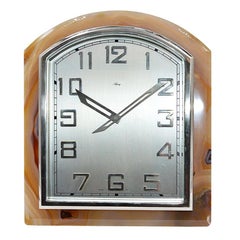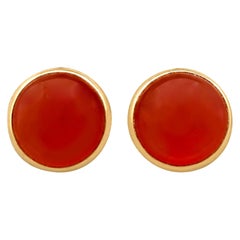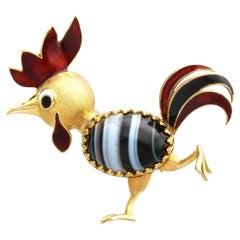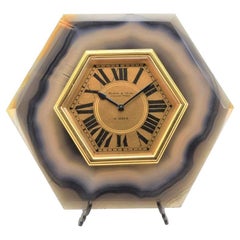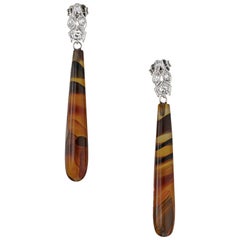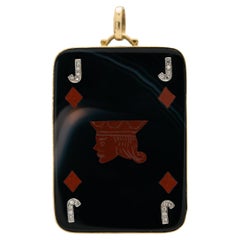Agate Jewelry
to
83
268
130
129
104
88
1,829
45,526
8,615
6,559
6,039
51
292
419
1,067
24
5
21
8
2
32
39
37
40
21
18
218
188
13
99
82
54
36
35
to
1
9
9
4
3
3
71
39
34
29
18
16
14
13
9
7
1
1
1
340
79
235
156
Gemstone: Agate
Period: 20th Century
Period: 1960s
Asprey Art Deco Agate Stone Clock, circa 1920s
Located in Long Beach, CA
FACTORY / HOUSE: Asprey London
STYLE / REFERENCE: Strut Desk Clock
METAL / MATERIAL: Polished Beveled Agate and Nickel
CIRCA / YEAR: 1920's / 1930's
DIMENSIONS / SIZE: Length 9.5" ...
Category
Mid-20th Century Swiss Agate Jewelry
Materials
Agate
5.50 Carat Cabochon Cut Agate and Yellow Gold Stud Earrings
Located in Jesmond, Newcastle Upon Tyne
An impressive pair of vintage 1980s 5.50 carat agate and 18 karat yellow gold stud earrings; part of our diverse gemstone jewelry and estate jewelry collections.
These fine and impressive vintage cabochon cut earrings have been crafted in 18k yellow gold.
Each earring displays a bezel set round cabochon cut agate.
The agates are surrounded by a plain border.
The earrings secure to the reverse with a post and butterfly fastening.
Each of the butterflies are hallmarked with the 18k gold fineness mark 750.
These vintage agate earrings...
Category
1980s Unknown Vintage Agate Jewelry
Materials
Agate, 18k Gold, Yellow Gold
1950s Italian 11.19ct Banded Agate, Enamel and 18k Yellow Gold Cockerel Brooch
Located in Jesmond, Newcastle Upon Tyne
A fine and impressive Italian 1950s 11.19 carat banded agate, enamel and 18k yellow gold cockerel brooch; part of our diverse vintage bird brooches collection.
This fine and impressive vintage brooch has been crafted in 18k yellow gold.
The yellow gold brooch has been modelled in the form of a illustrative cockerel.
The body of the bird is embellished with an impressive decorative claw set 11.19ct cabochon cut banded agate.
This exceptional brooch incorporates black and white hot enamel decoration representing the eye, in addition to red and black enamel reproducing the tail/sickle feathers, comb and wattle.
The brooch is further embellished with textured yellow gold components creating the legs, feet, head and beak; completing the design.
The agate bird brooch...
Category
1950s Italian Vintage Agate Jewelry
Materials
Agate, Yellow Gold, Enamel
Mappin & Webb Agate and Gilded Brass Art Deco Style Desk Clock
Located in Long Beach, CA
FACTORY / HOUSE: Mappin & Webb
STYLE / REFERENCE: Art Deco / Agate Stone Easel Desk Clock
MOVEMENT / CALIBER: 15 Jewels Swiss Made / Eight Days / Manual W...
Category
1920s Swiss Art Deco Vintage Agate Jewelry
Materials
Agate
11.62 Carat Banded Agate Diamond Platinum Dangle Earrings
Located in Stamford, CT
Vintage 1940's banded agate simple dangle earrings with 6 bead set diamonds in platinum tops.
2 pear shaped black brown cabochon banded agate cylinders, approx. 11.62cts
6 single c...
Category
Mid-20th Century Agate Jewelry
Materials
Agate, Diamond, Platinum
Vintage 18k Yellow Gold Agate and Carnelian Jack of Diamonds Pendant
Located in New York, NY
Vintage 18k Yellow Gold, Agate and Carnelian Jack of Diamonds Pendant c.1970s
According to those who ascribe tarot-like meaning to ordinary playing c...
Category
20th Century Unknown Agate Jewelry
Materials
Agate, Carnelian, Diamond, 18k Gold, Yellow Gold
Natural Agate and Emerald Cabochon Disc Pierced Earrings in 22 Karat Yellow Gold
Located in Scottsdale, AZ
Fabulously unique statement earrings filled with exceptional color and fine details. Each singular stone has its own natural striations, varying hues and raw design, creating a truly...
Category
20th Century Unknown Contemporary Agate Jewelry
Materials
Agate, Emerald, Gold, 22k Gold, Yellow Gold
Vintage Silver and Oval Cabochon Amber-Colored Carnelian Bracelet
Located in Jacksonville, FL
Make a bold fashion statement with this Beautiful Vintage Silver and Carnelian Bracelet. Crafted with intricate detail and showcasing a stunning combination of silver and carnelian, ...
Category
20th Century American Art Deco Agate Jewelry
Materials
Agate, Silver
18.00 Carat Banded Agate Yellow Gold Dangle Earrings
Located in Stamford, CT
1940's Agate dangle earrings with natural banded Agate with double snake chain tops on a simple wire.
2 natural untreated banded color Agate, approx. total weight 18.00cts, 39 x 19...
Category
Mid-20th Century Agate Jewelry
Materials
Agate, Gold, 14k Gold, Yellow Gold
Angela Cummings Agate Carnelian Yellow Gold Ear Clips, 1989
Located in New York, NY
Angela Cummings agate carnelian yellow gold ear clips, 1989
Square 18 karat yellow gold with four slightly curved lines of agate carnelian; marked Angela Cummings, 18k, 1989
Size: ...
Category
1980s Contemporary Vintage Agate Jewelry
Materials
Agate, Carnelian, Gold, 18k Gold, Yellow Gold
Pair of Agate & Sterling Silver Cufflinks
Located in Palm Desert, CA
A classic pair of cufflinks with an oval agate cabochon framed within a sterling rope detail. Stamped "Sterling" on the toggle.
Category
1960s American Vintage Agate Jewelry
Materials
Agate, Sterling Silver
XX century Agate Bracelet Cuff
Located in PARIS, FR
Agate, Sapphires and Diamonds
Weight: 144.1 grams
Category
20th Century European Agate Jewelry
Materials
Agate, Blue Sapphire, 18k Gold
Mellerio Paris, French Gold, Diamonds, Silver, Lapis, and Obsidian Polo Player
Located in New York, NY
Mellerio Paris, A French Gold, Diamonds, Silver-Gilt, Rock Crystal, Enamel, Emerald, Lapis Lazuli, Agate, Emerald, and Obsidian Polo Player, Carved Horse Sculpture, Jeweled Mounted Object.
An extremely rare and unique, one of a kind French Carved Horse Sculpture, Jeweled Mounted Object sculpture "CHEVAUX DE LEGENDE", "A Legendary Horse" by Mellerio, Paris, circa 1999.
Sitting on black obsidian base, the solid rock-crystal slab is finely applied with a carved obdisian hardstone horse and polo player, mounted in 18k gold, brilliant -cut diamonds, emaralds, enamel, lapis lazuli, and agate, .The obsidian base with a plaque engraved: CHEVAUX DE LEGENDE" / MELLERIO DITS MELLER PARIS / 5003 DIV
The piece is in excellent condition and comes with a custom made wood case made for transport. It's very elegant and has French hallmarks throughout. A truly magnificent piece.
Measures 12" high x 8" wide x 4" deep
Founded in France in 1613 by the descendants of Italian immigrants from the Vigezzo Valley in the north of Italy, Mellerio is one of the oldest jewellery houses in Europe. The family business soon attracted the attention of the Royal Court and Marie Antoinette herself reportedly purchased a precious bracelet featuring 7 cameos surrounded by rubies in 1780. Later on, in the 19th century, Mellerio became the official supplier of the French Royal family and the Court of Netherland.
Mellerio creates many jewellery items, all set with rare gems such as peridots, amethysts, aquamarines, citrines and topaz, applying for a patent, the flexible stem, a very supple and light jewellery mechanism. Mellerio remains also well known for their spectacular series of Art Nouveau jewels, created at the beginning of the 20th century, as well as for the creation of trophies rewarding some of the greatest footfall and tennis players of history. In 1993, the jewellery house launched their first watch collection.
Today, Mellerio has stores in Paris, Japan and Hong Kong.
July 14, 1789: this date is known throughout the world as the beginning of the French Revolution. According to a ledger belonging to House of Mellerio, this was also the day that the jeweler sold a golden key to the Comte de Coutance for 10 livres. This ledger, as well as inventories dating as far back as 1768, are the jeweler’s oldest archives. These archives have continued to grow over the years, as the House, established on rue de la Paix in Paris, still lives on today, still in the hands of the same family from Craveggia, in the North of Italy.
The tumultuous history of the Mellerio family in France probably goes as far back as the Italian wars of the Renaissance, but the first official document proving their commercial activity in Paris dates back to 1613. This document is the famous royal warrant awarded by Marie de Medici to a number of Italian families established along the rue des Lombards, including the Mellerios, allowing them to sell “small jewelery items”, therefore granting them a small exception to the traditional monopoly enjoyed by Parisian jewelers. At that time, powerful corporations regulated the operations and customs of Parisian business, but thanks to this exceptional warrant, the Mellerios managed to escape the confines of this framework. Today, this wax-sealed document is kept at the city hall of Craveggia.
From 1613 to the Revolution, the Mellerios lived between France and Italy. The corporations tried many times to put an end to their trade privileges, but all in vain, as a dynasty of sovereigns renewed the warrant. Always marrying and often retiring in Craveggia, the Mellerios continued to maintain their jewelry business in Paris. At first, they did this without a shop. Wearing backpacks (wooden boxes divided into small compartments where jewels were kept), they would tour town fairs around Paris and royal castles.
This is how Jean-Baptiste Mellerio (1765-1850) is said to have sold a bracelet set with rubies and Antique cameos to Marie-Antoinette, which still exists today. Many elements seem to prove the veracity of this anecdote. The queen was particularly fond of cameos, which cover the entire background of her famous jewelry cabinet, and ruby was her favorite stone after diamond. The famous bracelet, reacquired a few years ago by the House of Mellerio, is indeed an 18th century jewel, set with antique cameos representing the profiles of Roman emperors. Two branches of the family were operating in Paris during this time, under the reign of Louis XVI: that of Jean-François (1746-1828), the paternal ancestor of the current Mellerios, and that of Jean-Baptiste (1765-1850).
The French Revolution forced them to return to Italy. However, both Jean-Baptiste and François Mellerio (1772-1843), who was the son of Jean-François, were eventually able to return to Paris after the founding of the Consulate. Jean-Baptiste opened a shop at the Iron Crown of rue Vivienne, and François opened his at the Palais des Tuileries, rue du Coq Saint-Honoré. His well-organized order books give an idea of his high-ranking clientele during the “Old Regime”, among which were the Comte and Comtesse Octave de Segur, the Marquise (later Duchess) de Tourzel, former governess of the royal children, and her daughter, the Comtesse de Bearn, the Craufurds -who organized the flight to Varennes, the Duc and Duchess de Gramont, the Comtesse de Boigne, and Madame de Souza, Talleyrand’s mistress.
We also see the names of the imperial family: Empress Josephine, the Queen of Holland, Princess Elisa, Caroline and Pauline. At that time, the House of Mellerio specialized, among other things, in the trade of antique cameos, a newly fashionable genre of jewel that captured the imagination of all the princesses and noble women of the time.
The years of the Restauration and July Monarchy were among the most glorious. The Bourbons were back on the throne, and the clientele of the House of Mellerio had regained its former wealth. Mellerio supplied Louis-Philippe, Duke of Orléans, as well as his mother, wife and sister, with sumptuous jewels, including a set of emeralds made piece by piece, while the Duke of Bourbon, last prince of the House of Condé, offered diamonds to his mistress, the scheming Baronne de Feucheres, and Monsieur de LaFayette also bought cameos for one of his granddaughters. For the first time, Mellerio ventured into the world of arts in 1815, when Carlotta Grisi, a famous dancer who created Giselle, as well as an actress named Rachel, bought jewels at the Mellerio store on rue de la Paix.
1848 marked a new turning point. France once again became a Republic. François Mellerio handed the company over to his son, Jean, and the latter decided to travel to Spain to build a new clientele. He later became one of the jewelers of the royal family, and met Eugénie de Montijo, who remained a faithful client when she became empress of the French people. The Imperial years were lavish. During the Second Empire, Paris was a pageant of crinoline dresses designed by Worth, while jewels by Mellerio, Worth’s neighbour on the rue de la Paix, adorned the noble women of the Tuileries court.
The Empress bought pearls. Mathilde Bonaparte...
Category
20th Century French Art Deco Agate Jewelry
Materials
Agate, Diamond, Emerald, Rock Crystal, Gold, Silver
Recently Viewed
View AllMore Ways To Browse
Yellow Pierre Cardin
Alexandra Rose
Celine 1990s
Celine 1990s
Chanel Vintage Crystal Cc
Cheetah Jewelry
Deco Tiara
Diamond Large Mirror Emerald
Venezuela Jewelry
Vintage Lion Costume
8mm Cuban
80 Point Diamond
Antique Hand Tinted Photographs
Antique Victorian Dress 1890s Dresses
Champagne Golden Pearls
Chinese Stamp Jade
D G Initials
David Webb Dragon
